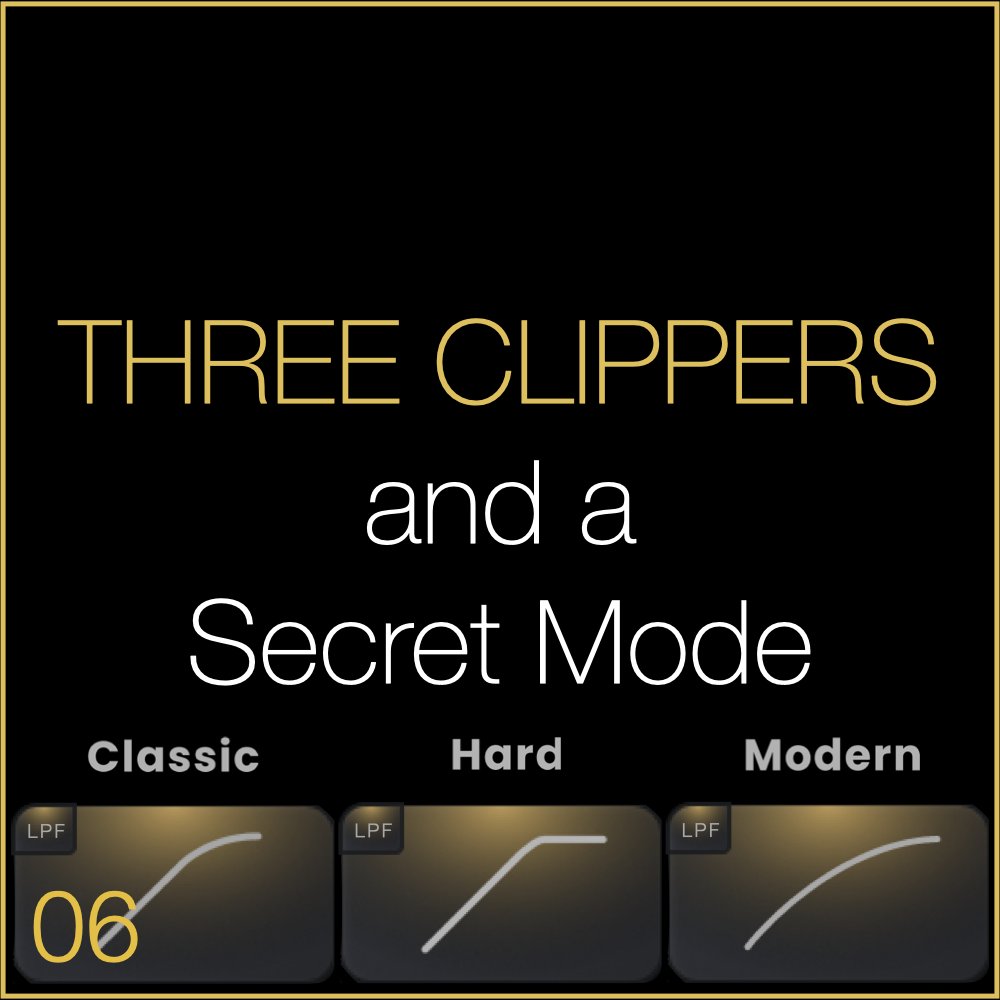04) Discover the Power of GOLD
Gold, the namesake feature of GOLD CLIP, redefines compression. Unlike traditional compressors that rely on attack and release times, Gold performs a sample-by-sample analysis of your audio, applying non-linear gain to enhance perceived loudness. Peaks and transients remain untouched, while low-level material and sustain are brought forward, adding depth and presence.
This instantaneous compression works like tape, delivering natural, smooth loudness—without the artifacts caused by attack and release stages. The result? Transients stay fast, clean, and natural, while your mix gains a unique sense of sonic "inflation," making sounds feel bigger and fuller.
When used on your master fader, Gold’s clean approach to loudness can transform how you compress instruments and buses feeding into GOLD CLIP. It’s more than just a tool—it’s a whole new way to shape your sound.
Two Types of GOLD
Modern: Gentle & Transparent Loudness Processing
The Modern setting emulates the soft-knee loudness processing of a renowned mastering converter from 2022, offering a refined, transparent approach to loudness enhancement. Designed for subtlety, Modern provides a gentler and more forgiving form of compression, making it ideal for maintaining clarity and preserving natural dynamics in your mix.
Modern applies less gain than Classic, using a shorter knee to achieve smooth loudness processing. With a maximum of 2.5 dB of gain compared to Classic’s 6 dB, Modern excels at adding just enough loudness without introducing noticeable harmonic coloration. This makes it a perfect choice for clean, polished results, whether on individual tracks or your master bus.
2.5dB of Modern GOLD
Classic: Soft-Knee Saturation with a Punch
Classic emulates the soft-knee loudness processing of a well-loved mastering converter from the late 2000s. While it features a softer knee for amplitude saturation, it delivers a more aggressive sound than Modern and generates greater harmonic excitement at higher settings.
What sets Classic apart is its dynamic knee behavior. The knee’s shape varies based on the amount of Gold applied, starting as low as 12 dB below the clip point when set to 6 dB. This unique design allows for precise control and tonal shaping, making Classic a versatile choice for enhancing loudness with character.
6dB of Classic GOLD
Which to choose?
When mastering, I recommend starting with Modern Gold processing. With its maximum gain of 2.5 dB, it delivers a clean, transparent sound, ideal for dense content like full mixes.
On the master fader, Gold Clip can be placed either first in the chain or just before your final limiter. Placing it first allows you to shape dynamics early, while positioning it just before the limiter ensures maximum loudness and smoothness at the final stage.
For more aggressive processing, Classic Gold is the better option. Its longer knee and higher gain make it perfect for signals with a wider dynamic range, such as drum buses, 808s, effects returns, or vocals.
Choose based on the content and the result you're aiming for—both are powerful tools in the right context.
What is Gold Unity?
Gold Unity is straightforward. If you apply 6 dB of nonlinear gain with Gold, Unity automatically reduces the output by 6 dB of linear gain after Gold. This maintains perceived volume while reducing peaks, allowing you to focus on the compression effects of Gold without being misled by an increase in loudness.
Just remember that the more aggressive clipping you do, the less clean gold processing will sound. When using Gold for loudness, I like to keep my clipping to a minimum.
Here's a quick video example of this entire setup.
Give it a try and hit reply to let me know what you think. Or, tag @SchwabeDigital in an instagram story and show us how you are using it. We'll repost.
In the next post, we'll talk about the companion to Gold, called Alchemy.
Be well,
Ryan Schwabe
Grammy-nominated and multi-platinum mixing & mastering engineer
Founder of Schwabe Digital
p.s. Subscribe below for updates on Schwabe Digital Plugins.















